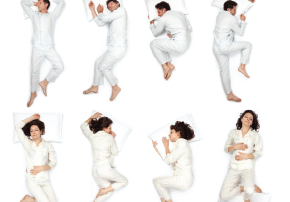How To Improve Your Sleeping Posture.

How To Improve Your Sleeping Posture.
It’s a nightly routine we give hardly a second thought to. We all have a natural, go-to position that affords us our best night’s rest. Whatever is most comfortable is what’s going to work. But are there preferred, or recommended, ways of sleeping that could help us, not just to sleep more effectively, but wake up physically and mentally more refreshed?
Sleep scientist, Dr Dale Rae, looks into common sleep postures that might aid, or even detract from, better sleep. But first, let's start with a physical factor that is key to any sleeping position. The spine.
For better sleep, align your spine.
The spine is the core connector from the brain to the body, and from the body back to the brain. It houses the spinal cord which is the vital conductor of motor commands, reflexes and sensory information. It’s the all-important backbone that keeps us fully functional. The spine also supports flexibility, like turning the head, bending, or lateral swiveling of the hips.
Ensuring that the spine is kept neutrally supported is what helps the body fully relax. Preferably, you want to avoid that morning crick in the neck, those groans of stiffness, or a sudden midnight wake-up because you’ve rolled over into an uncomfortable, contorted position.
Keeping your spine properly aligned is the anchor for a healthy, comfortable sleeping posture. Whatever your preferred position that gets you to relax and fall asleep, there are ways to ensure that your spine is well supported.
Common sleep positions – pros and cons.
1. The flat back – This would seem to be the obvious position for a perfectly aligned spine. With a shallow pillow at your head, so that your neck is not awkwardly bent, your arms folded or lying restfully to the side, and your legs straight out, this is a fully relaxed, or ‘surrendered’ sleep posture. There’s possibly a zen-like composure about imagining a full night’s sleep without so much as moving a muscle. And your spine remains perfectly positioned and rested. But is this a sustainable position throughout the entire night? Not likely.
2. Side sleeping – It is common to roll over during the night. Subconsciously you feel the need to relieve your resting place from one side to the other. It may likely be the waist area and the small of your back that needs pressure relief. If you find that you’re rolling over too often and not getting deeper, more restorative rest, try supporting your waist area with a pillow. This will help to keep your spine better aligned, whichever side you roll to. Another way to align your spine in a side position is to place a pillow in between your lower legs. This makes the upper legs more parallel with your mattress, which in turn supports the lower spine. And because you’re also resting on a shoulder, your head may need an extra pillow to support the neck.
3. Knees up – There are two sleeping postures where the knees are bent to provide extra comfort. The fetal, side position is often assumed where we curl up with a sense of comfort and security. This can also provide some pelvic pressure relief. As another form of side sleeping, you may want to consider the support of a pillow under the waist area. Then there is the flat back position with knees up. This can also help to release pelvic pressure by straightening out the base of the spine. If you find this posture the most comforting, consider a couple of strategically placed pillows under your bent knees. It can help to stabilise your preferred sleeping position.
4. Full frontal – Ever got home, totally exhausted, and flopped headlong onto your bed? Only to wake up soon enough with a really bad neck and back ache? Perhaps that’s why sleeping on your stomach is not usually recommended. However, for some, a comforting way to fall asleep can be the frontal pillow hug. Once you’ve nodded off, you’ll likely shift your sleeping posture during the night. Just keep in mind the two potential pressure points that could be vulnerable: the neck and the mid to lower back. Sleeping on your front means you’ll need to turn your head to either side to breathe. And, as you relax into deeper sleep, your spine will tend to relax and sink in towards the abdominal area. You can offset this slightly by leaning to one side, still in a frontal position, but taking off some of the neck and back pressure if you were to lie completely prone.
But what if there are situations when you can’t sleep in your ideal position? There can be several scenarios. Let’s take a look.
Remedial sleep postures.
1. Recovering from injury – It may be intuitive to sleep in a position with the least pressure on any injured part of your body. If you’ve had surgery, your surgeon or medical professional will suggest an optimal sleeping position for ease of pressure and recuperation. In severe cases, you may even need to isolate the movement of your injured area.
2. Sleeping through pregnancy – When you get to that time in your third trimester where you’re practically carrying an abdominal medicine ball around, both waking and sleeping hours can be – how shall we say – challenging? The weight is likely too pressing to sleep comfortably on your back. And front sleeping is clearly not an option. Side sleeping it has to be, again with a little help from strategically supporting pillows. Consider also a pillow between the legs that could alleviate lower spine pressure.
3. Restless sleep – If you find your bedding in a mangled disarray each morning, chances are you're thrashing about at night. There is no particular sleeping posture that could resolve your nocturnal restlessness. You might try anchoring yourself to either side with a few pillows. Or take a quiet moment just before bedtime to breathe deeply, empty your thoughts and purposefully engage in a state of relaxation. If you routinely wake feeling unrefreshed and are concerned about your sleep, you may wish to seek help from a medical professional to get to the bottom of the reasons for your restless sleep.
Sink into the perfect sleeping posture.
The point of a proper, quality night’s rest is that your mind and body are able to relax and regenerate completely. You just want to let yourself go. That wonderful sensation of sinking into a deep sleep is usually because you feel comfortably positioned. There’s no point in changing your natural, go-to sleeping posture. But if you’re waking up a little stiff and cranky, the first thing to address is whether your sleeping position could do with better spine alignment.
For better sleeping posture, head straight to Dial•a•Bed.
If you’ve been sleeping on the same mattress for over 8 years, you may want to consider a visit to Dial•a•Bed. Mattresses don’t maintain their level of support forever. And the gradual sagging of a spring or foam mattress over many years is hardly discernible. Except, perhaps you start waking up with back niggles or stiffness. And you can’t quite work out why. That's your cue to try a Dial•a•Bed in-store Comfort Testing Station and compare the perfect comfort and support you could be sleeping on. Find your nearest Dial•a•Bed store here. Then come and try out your favourite sleeping postures. #SleepForLife.
TAKE CARE: Lifestyle recommendation is not medical advice. Always consult your healthcare professional should you be experiencing prolonged sleep difficulties or related health issues. *Ts & C’s apply.






